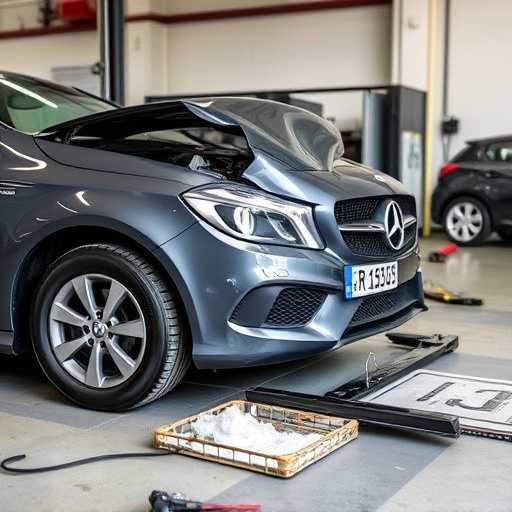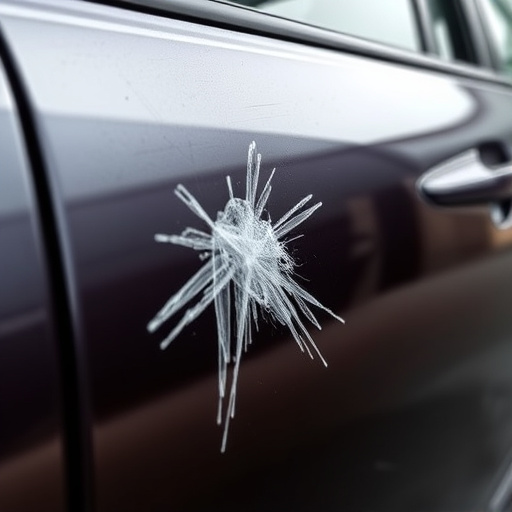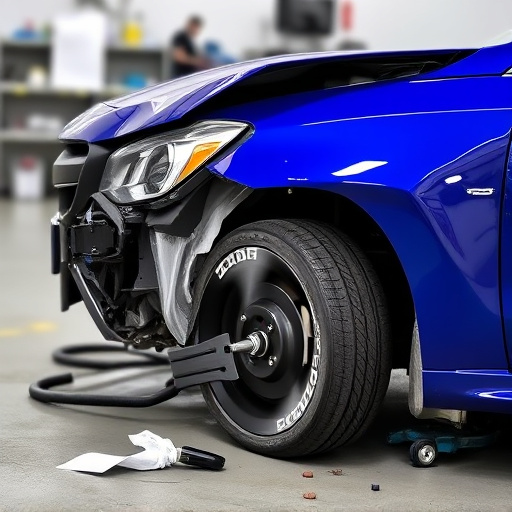Avoiding Taillight Repairs: Tips for Longevity & Quality Parts

Taillight repair and replacement are essential for vehicle safety and cost savings. Regular cleaning…….
In the realm of automotive maintenance and safety, taillight repair and replacement stand as a critical aspect often overlooked yet crucial for roadworthiness and driver visibility. This article aims to delve into the intricate world of taillight repairs, exploring its global impact, technological advancements, and the challenges it faces. By the end, readers will gain a comprehensive understanding of why this seemingly simple task is a significant contributor to road safety and vehicle longevity.
Definition: Taillight repair replacement involves the process of fixing or replacing damaged or faulty taillights in vehicles. This includes both the exterior lights that illuminate at night and the internal components ensuring their proper function.
Core Components: The primary elements include the taillight assemblies, housing, lenses, bulbs (or LEDs), wiring harnesses, and relay modules. Each component plays a vital role in the overall lighting system, contributing to the vehicle’s visibility during low-light conditions.
Historical Context: The concept of tail lights dates back to the early 20th century when automobiles first emerged as a common mode of transportation. Initially, these were simple gas lamps, evolving into electric bulbs with the advancement of technology. Over time, taillights became more sophisticated, incorporating advanced lighting technologies and safety standards to enhance driver visibility and prevent accidents.
Significance: Taillight repair is not merely about maintaining aesthetics; it is a critical safety measure. Functional taillights play a dual role: they signal a vehicle’s presence to other drivers, especially at night or in poor visibility, and they provide adequate lighting for the driver to navigate safely. Regular maintenance ensures these lights remain effective, contributing to overall road safety.
The practice of taillight repair replacement has transcended geographical boundaries, influencing automotive industries worldwide. Key trends shaping this sector include:
Increasing Adoption of LED Technology: Light Emitting Diodes (LEDs) have become the go-to choice for taillight manufacturers due to their energy efficiency, longer lifespan, and superior brightness compared to traditional incandescent bulbs. This trend is evident in many countries, with regulatory bodies pushing for LED adoption to improve road safety.
Regional Variations: Different regions exhibit unique patterns in taillight repair preferences. For instance, North America tends to prioritize advanced lighting systems and crash testing standards, while European countries focus on environmental compliance and energy-efficient technologies. Asia-Pacific markets are known for their rapid technological advancements, often introducing innovative taillight designs.
Global Supply Chain Dynamics: The global supply chain for taillight components is complex, with manufacturers spread across multiple continents. Factors like production costs, labor rates, and regulatory differences impact the pricing and availability of parts, affecting repair and replacement processes worldwide.
Market Dynamics: The global automotive lighting market, including taillight repairs, experienced steady growth in recent years. This growth is attributed to rising vehicle ownership, increasing demand for safety features, and technological advancements driving innovation. According to a 2021 report by Grand View Research, the market size was valued at USD 47.5 billion in 2020 and is expected to grow at a CAGR of 6.5% from 2021 to 2028.
Investment Patterns: Major automotive manufacturers invest heavily in research and development (R&D) for lighting systems, ensuring their products meet the latest safety standards and consumer expectations. This includes tailoring taillight designs to different market segments and regions, driving innovation and competition within the industry.
Economic Impact: Taillight repair replacement contributes to economic growth by supporting:
The field of taillight repair has witnessed significant technological breakthroughs, revolutionizing both the repair process and the lighting systems themselves:
| Technology | Description | Impact |
|---|---|---|
| LED Lighting: As mentioned earlier, LEDs have become the standard for taillights due to their advantages in energy efficiency, brightness, and longevity. This technology allows for more intricate lighting designs and better control over light distribution. | Enables slimmer light profiles, improved visibility, and reduced power consumption. | Leads to lighter vehicles and lower operating costs. |
| Smart Taillights: Integrated with vehicle sensors and advanced driver-assistance systems (ADAS), smart taillights can adapt their brightness and patterns based on driving conditions. | Enhances safety by providing dynamic lighting for emergency braking, turn signals, and surrounding traffic awareness. | Reduces blind spots and improves overall visibility during critical maneuvers. |
| Wireless Updates: Taillight components can now receive software updates wirelessly, allowing manufacturers to introduce new features or fix issues remotely. | Enables over-the-air (OTA) updates, ensuring taillights remain current with the latest safety standards and technologies. | Promotes efficient and cost-effective lighting system maintenance. |
| 3D Printing: This additive manufacturing technique is used for creating custom taillight components, offering design flexibility and potential cost savings. | Allows for unique light designs and rapid prototyping, enabling faster product development cycles. | Can reduce production times and costs while enhancing aesthetic customization. |
Government regulations play a pivotal role in shaping the landscape of taillight repair replacement:
Safety Standards: Many countries have established stringent safety standards for vehicle lighting, including taillights. These standards dictate minimum brightness levels, light distribution patterns, and durability requirements. For instance, the European Union’s ECE Regulation 37 provides guidelines for various lighting systems, ensuring consistent performance across vehicles.
Environmental Regulations: As LED technology becomes more prevalent, regulations focusing on energy efficiency and waste management come into play. The RoHS Directive in Europe restricts the use of certain hazardous substances in electrical and electronic equipment, influencing taillight component composition.
Import and Export Controls: International trade policies impact the availability of taillight components, especially for vehicles manufactured or modified outside a country’s borders. Tariffs and import/export regulations can affect pricing and supply chain dynamics.
Despite its importance, taillight repair replacement faces several challenges:
High Replacement Costs: In some cases, replacing taillights, particularly on luxury or high-performance vehicles, can be expensive due to the use of advanced technologies and specialized parts. This may deter owners from conducting timely repairs.
Lack of Skilled Technicians: The demand for skilled technicians capable of handling complex lighting systems outpaces the supply in many regions. Inadequate training and certification programs can lead to inconsistent repair quality.
Counterfeit Parts: The market for counterfeit automotive parts, including taillight components, is a significant concern. These substandard parts may fail prematurely, posing safety risks and damaging consumer trust.
Proposed Solutions:
Case Study 1: Germany’s LED Revolution
Germany took a leading step towards energy-efficient taillight systems by mandating that all new vehicle models meet specific LED lighting standards. This initiative resulted in widespread adoption of LED taillights, reducing power consumption and carbon emissions. The success lies in the government’s supportive policies, encouraging manufacturers to innovate while ensuring consumer safety.
Case Study 2: Japan’s Advanced Safety Features
Japanese automakers are renowned for their focus on safety, and taillight technology is no exception. Toyota, for instance, implemented intelligent tail lights that adapt to driving conditions, improving visibility and reducing accidents. This case highlights the effectiveness of integrating advanced technologies into taillight systems to enhance overall vehicle safety.
The future of taillight repair replacement appears promising, with several emerging trends and growth areas:
Autonomous Vehicles: As self-driving cars become more prevalent, taillight designs may evolve to accommodate new safety requirements, such as advanced lighting cues for pedestrian awareness and vehicle-to-vehicle communication.
Integration with ADAS: The integration of taillights with other Advanced Driver Assistance Systems (ADAS) will continue, providing dynamic lighting solutions for improved road safety.
Sustainable Materials: There is a growing trend towards using sustainable materials and manufacturing processes in automotive lighting, aligning with global efforts to reduce environmental impact.
Personalized Lighting: With advancements in 3D printing and design software, taillight customization will become more accessible, allowing owners to express their individuality through unique lighting patterns and styles.
Taillight repair replacement is a dynamic and evolving aspect of the automotive industry, playing a critical role in vehicle safety and technological advancement. As global trends continue to shape this sector, the focus on energy efficiency, advanced lighting technologies, and safety will remain paramount. By addressing challenges, embracing innovations, and adhering to regulatory frameworks, the future of taillight maintenance promises enhanced road safety, improved vehicle performance, and personalized lighting experiences.
Q: How often should I replace my taillights?
A: The frequency depends on several factors, including driving habits, environmental conditions, and the quality of your current lights. As a general guideline, consider replacing taillights every 3-5 years or when you notice decreased brightness or flickering.
Q: Can I install LED taillights myself?
A: While some basic repairs can be done by enthusiasts, installing LED taillight assemblies often requires specialized knowledge and tools. It is recommended to seek professional assistance for proper installation and to ensure optimal performance and safety.
Q: Are there environmental benefits to using LED taillights?
A: Absolutely! LEDs are significantly more energy-efficient than traditional bulbs, reducing power consumption and lowering carbon emissions. This contributes to a greener transportation system.
Q: How can I tell if my taillights need replacing?
A: Signs include dim or flickering lights, uneven brightness, or difficulty in seeing at night. If you notice any of these issues, it’s advisable to have them inspected and replaced for safety purposes.

Taillight repair and replacement are essential for vehicle safety and cost savings. Regular cleaning…….

Taillight repair replacement is a meticulous process vital for vehicle safety and aesthetics. It inv…….

Repairing or replacing taillights requires understanding local regulations and using identical repla…….

Taillight repair or replacement demands adherence to safety standards and regulations for driver saf…….

Before attempting a taillight repair replacement, gather necessary tools and compatible parts. Park…….

Environmental factors like extreme temperatures, UV exposure, and air pollutants accelerate tailligh…….

Taillight repair replacement is crucial for enhanced road safety and visibility. Technicians identif…….

Taillight repair/replacement requires thorough assessment of housing, wires, fuses, and control modu…….

Understanding your auto insurance policy is vital for managing costs of taillight repair replacement…….

When replacing a taillight, review guarantees from auto shops to protect against unforeseen costs an…….